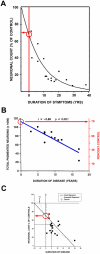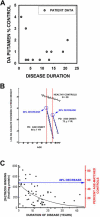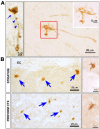Axon degeneration in Parkinson's disease
- PMID: 22285449
- PMCID: PMC3340476
- DOI: 10.1016/j.expneurol.2012.01.011
Axon degeneration in Parkinson's disease
Abstract
Parkinson's disease (PD) is the most common neurodegenerative disease of the basal ganglia. Like other adult-onset neurodegenerative disorders, it is without a treatment that forestalls its chronic progression. Efforts to develop disease-modifying therapies to date have largely focused on the prevention of degeneration of the neuron soma, with the tacit assumption that such approaches will forestall axon degeneration as well. We herein propose that future efforts to develop neuroprotection for PD may benefit from a shift in focus to the distinct mechanisms that underlie axon degeneration. We review evidence from human post-mortem studies, functional neuroimaging, genetic causes of the disease and neurotoxin models that axon degeneration may be the earliest feature of the disease, and it may therefore be the most appropriate target for early intervention. In addition, we present evidence that the molecular mechanisms of degeneration of axons are separate and distinct from those of neuron soma. Progress is being made in understanding these mechanisms, and they provide possible new targets for therapeutic intervention. We also suggest that the potential for axon re-growth in the adult central nervous system has perhaps been underestimated, and it offers new avenues for neurorestoration. In conclusion, we propose that a new focus on the neurobiology of axons, their molecular pathways of degeneration and growth, will offer novel opportunities for neuroprotection and restoration in the treatment of PD and other neurodegenerative diseases.
Keywords: 1-methyl-4-phenyl-1,2,3,6-tetrahydropyridine; 1-methyl-4-phenylpyridinium; 6-OHDA; 6-hydroxydopamine; AAV; AD; AVs; Akt; Alzheimer's disease; Autophagy; DLB; ILB; LB; LRRK2; Lewy body; MFB; MPP(+); MPTP; PD; Parkinson's disease; SN; Striatum; Substantia nigra; TH; VMAT2; Wallerian degeneration slow; Wld(S); [(3)H]TBZOH; adeno-associated virus; autophagic vacuoles; dementia with Lewy Bodies; incidental Lewy bodies; leucine rich repeat kinase 2; mTor; medial forebrain bundle; substantia nigra; tritiated α-dihydrotetrabenazine; tyrosine hydroxylase; vesicular monoamine transporter; α-Synuclein.
Copyright © 2012 Elsevier Inc. All rights reserved.
Figures






References
-
- Agid Y, Agid F, Ruberg M. Biochemistry of neurotransmitters in Parkinson's disease. In: Marsden CD, Fahn S, editors. Movement Disorders 2. Butterworths; London: 1987. pp. 166–230.
-
- Bernheimer H, Birkmayer W, Hornykiewicz O, Jellinger K, Seitelberger F. Brain dopamine and the syndromes of Parkinson and Huntington. Clinical, morphological and neurochemical correlations. J Neurol Sci. 1973;20:415–455. - PubMed
-
- Bonifati V, Rizzu P, van Baren MJ, Schaap O, Breedveld GJ, Krieger E, Dekker MC, Squitieri F, Ibanez P, Joosse M. Mutations in the DJ-1 gene associated with autosomal recessive early-onset parkinsonism. Science. 2003;299:256–259. - PubMed
Publication types
MeSH terms
Grants and funding
LinkOut - more resources
Full Text Sources
Other Literature Sources
Medical
Miscellaneous

